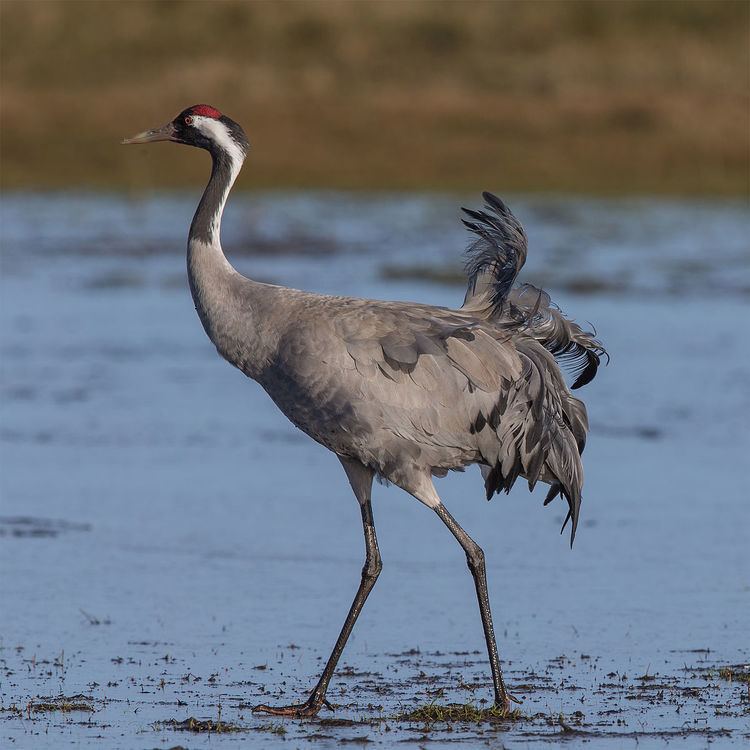 | ||
Cranes are large, long-legged and long-necked birds of the order Gruiformes. Two species occur as wild birds in Britain: the common crane, a scarce migrant and very localised breeding resident, and the sandhill crane, an extreme vagrant from North America. A third species, the demoiselle crane, has been recorded on a number of occasions, but these birds have not generally been accepted as being of wild origin.
Contents
- Historical occurrence
- Migrant status
- Recolonisation of the Norfolk Broads
- The 1980s
- The 1990s
- The 2000s
- Recent summering birds elsewhere in Britain
- The Great Crane Project
- Sandhill crane
- Demoiselle crane
- References
A number of other species are kept in captivity, resulting in the possibility of escapees being seen.
Historical occurrence
The common crane is generally believed to have been a breeding bird in Britain in the Middle Ages. Confusion arises as the grey heron was, and still is, known as "crane" in many parts of rural England. Among the strongest evidence that common cranes did genuinely occur was the fact that an Act of Parliament of 1533 included a measure that made the taking of cranes' eggs an offence, punishable by a fine, and five mentions in the "Household book of the L'Estrange family" of the supply of cranes for their larder between 1519 and 1533.
English place names with the prefix "Cran" are not infrequent, and derive from the bird, for example the name of Cranfield in Bedfordshire derives from the Anglo-Saxon crane feld - open country frequented by cranes.
Migrant status
Common crane is a scarce spring and autumn migrant to Britain, with occasional birds remaining in winter or summer. The British Trust for Ornithology estimates in 2017 the UK breeding population of cranes is 10 pairs. 52 cranes were identified in the UK in winter, and 37 cranes were recorded as passage migrants. The European population of cranes in summer is estimated to be 50 to 70 thousand pairs.
Recolonisation of the Norfolk Broads
In the late 20th century, common crane recolonised the Norfolk Broads; the species has now established a resident population of some 20 individuals. This population is centred on the northeastern part of the Broads, in the Sea Palling / Horsey / Hickling area.
The origins of this population can be traced to 15 September 1979, when two birds appeared near Hickling Broad; these two were joined by a third bird on 10 October. On 7 October, a crane with a rubber object wrapped around its bill was found in the Irstead / Horning area. It was taken into care and released on Horsey in March 1980, temporarily bringing the population to four.
The 1980s
By the end of April 1980, only two birds remained; however, these birds stayed throughout 1980 and 1981, and in 1982 raised a single young, the first successful breeding in Britain for around four hundred years. A second young was raised in 1983, but disappeared before the end of the year. An additional bird joined the group on 16 August 1982, and remained with them until at least 1987.
Further breeding attempts were made from 1985 through until the end of the 1980s, those in 1986 and 1988 being successful, with one young each raised. In addition, further migrant birds joined the flock; not all stayed, however both the wintering and summering populations steadily grew, as shown below:
The 1990s
During most of the 1990s, the population remained steady; however with several successful breeding attempts in the late 1990s, the population began to climb into double figures. Data on the 1990s' populations and breeding activity are as follows:
The 2000s
Figures for the 2000s so far:
Recent summering birds elsewhere in Britain
Away from the Broadland population, other birds have shown breeding behaviour, including:
The Great Crane Project
In 2009, the Wildfowl and Wetlands Trust, The RSPB and the Pensthorpe Conservation Trust, with funding from Viridor Credits Environmental Company, began a partnership project which aims to re-establish a breeding population of cranes at a new wetland site in the UK, helping to secure the crane's future as a breeding species. A rearing facility or "crane school" was set up at WWT Slimbridge; this consists of a 1-acre (4,000 m2) marsh garden designed to rear crane chicks between 2010 and 2014 in as close to a wild environment as possible. A pre-release enclosure was also constructed on the Somerset Levels. Although the cranes are hand-reared, all humans having contact with the birds wear special grey cover-all smocks, complete with hoods, and feed the cranes using plaster cast crane heads mounted onto litter picker handles. Approximately 20 cranes are reared and released each year. The first cranes were released in 2010 with annual releases planned up until 2014. The cranes are released in Somerset, on the Somerset Levels and Moors, where the project is also working with farmers and landowners to create suitable breeding areas for the birds.
Sandhill crane
Sandhill crane is a very rare vagrant in Britain, having been recorded just four times, twice in Shetland:
Elsewhere in Europe, there are records of sandhill crane from Galley Head, County Cork, Ireland in September 1905, and from the Faroe Islands on 14 October 1980.
Demoiselle crane
Demoiselle crane has been recorded a number of times — in Cumbria, Dorset, Hampshire, Kent, Lanarkshire, Lancashire, Lothian, Norfolk, Orkney, the Western Isles and Yorkshire. The origin of these birds is not known, and they have not been accepted onto the British List.
